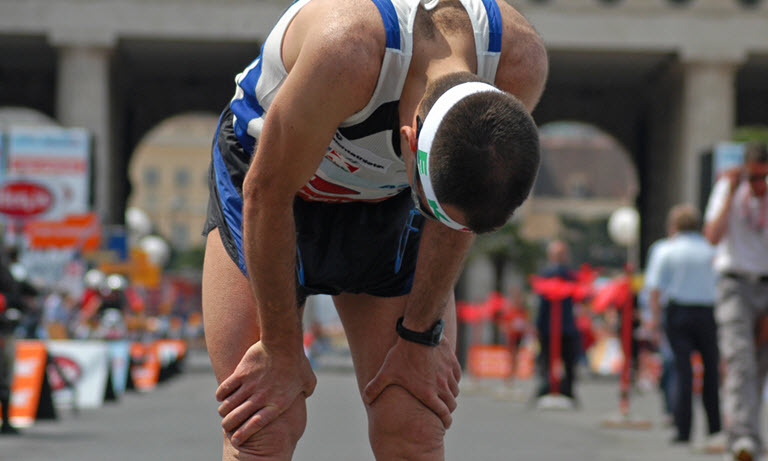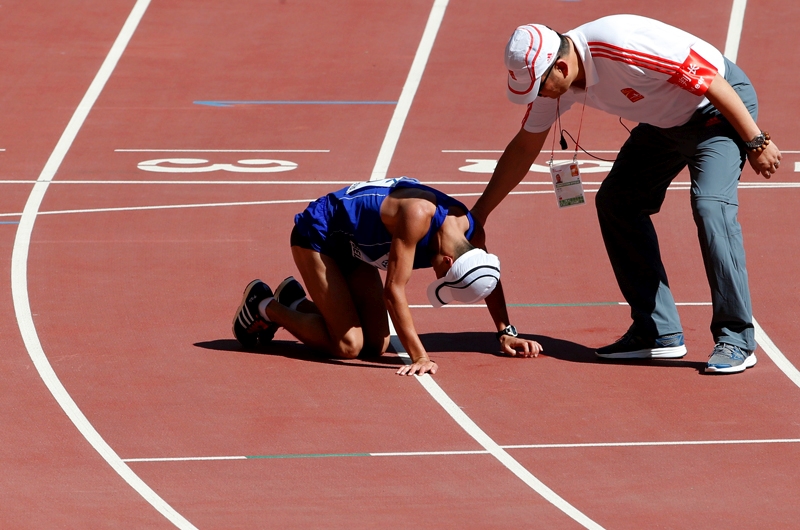When Do Marathon Runners Hit the Wall
Marathon runners usually hit the wall around mile 20 due to depleted glycogen stores. This is known as “bonking.”
For many long-distance runners, hitting the wall can be a daunting experience. The term “hitting the wall” refers to a sudden depletion of glycogen stores in the muscles, leading to extreme fatigue and a feeling of running through molasses. Typically occurring around mile 20 of a marathon, this physical and mental barrier can make it challenging to continue running at the same pace, causing some runners to slow down significantly or even stop.
Understanding this phenomenon and how to prevent it through proper nutrition and pacing is crucial for marathon runners aiming to cross the finish line strong and with a sense of accomplishment.

Credit: www.akronmarathon.org
Factors Affecting Runner’s Performance
When it comes to marathon running, hitting the wall is a dreaded experience. It refers to a sudden loss of energy and feeling of exhaustion that can occur around the 20-mile mark. Several factors can contribute to this phenomenon, affecting both a runner’s physical and mental performance. Understanding these factors can help athletes better prepare for the challenges that lie ahead. Let’s explore the physical and mental aspects that impact a runner’s performance.
Physical Factors
1. Lack of Proper Training: marathon training is essential to build endurance and stamina. Inadequate preparation can lead to early exhaustion and a higher likelihood of hitting the wall.
2. Insufficient Nutrition: proper fueling is crucial for marathon runners. Without consuming enough carbohydrates and staying hydrated, the body can deplete its energy stores faster, leading to fatigue.
3. Overexertion: pushing too hard during training or the race itself can drain the body’s energy stores faster than it can replenish them.
4. Inadequate Rest: a lack of sufficient rest and sleep can impair the body’s ability to recover and perform optimally.
Mental Factors
1. Lack of Mental Resilience: maintaining a positive mindset and mental toughness is crucial in long-distance running. Negative thoughts and self-doubt can affect performance and increase the chances of hitting the wall.
2. Poor Race Strategy: planning and pacing oneself properly during a marathon is essential. Starting too fast or not having a well-thought-out plan can lead to premature exhaustion.
3. Lack of Focus: maintaining concentration throughout the race is vital. Mental distractions or losing focus can negatively impact a runner’s performance.
4. Lack of Experience: novice runners may be more prone to hitting the wall due to unfamiliarity with the physical and mental demands of marathon running.
To avoid hitting the wall, marathon runners should focus on a comprehensive training program, properly fuel their bodies, and develop mental resilience. By understanding and addressing these physical and mental factors, athletes can improve their performance and increase the likelihood of crossing the finish line triumphantly.
Understanding The Concept Of Hitting The Wall
Marathon runners often face the daunting challenge of hitting the wall during a race, which can significantly impact their performance and overall experience.
Physical Exhaustion
Physical exhaustion is a key factor contributing to marathon runners hitting the wall, as the body struggles to maintain the intense level of activity for an extended period.
Depletion Of Glycogen Stores
Depletion of glycogen stores is another critical issue that leads to hitting the wall, as the body’s primary energy source becomes depleted, causing fatigue and a decline in performance.
Identifying Warning Signs
Marathon runners can encounter the dreaded wall when their body and mind reach a breaking point. Being able to identify warning signs is crucial in preventing a potential collapse during a race.
Physical Symptoms
- Sudden fatigue and heaviness in the legs
- Dizziness and lightheadedness
- Cramping or muscle spasms
- Nausea or gastrointestinal issues
Mental Symptoms
- Difficulty focusing or maintaining pace
- Feelings of overwhelming exhaustion
- Anxiety or a sense of dread
- Negativity and increased irritability
If you notice any of these signs during a marathon, it’s essential to take immediate action to prevent hitting the wall and ensure a successful race.
Strategies To Avoid Hitting The Wall
When it comes to marathon running, one of the biggest challenges that runners face is hitting the wall. This occurs when the body’s glycogen stores become depleted, resulting in a sudden drop in energy levels and a feeling of extreme fatigue. However, with the right strategies in place, runners can avoid hitting the wall and finish strong. In this article, we will explore some effective strategies, from nutritional preparation to training techniques, to help marathon runners stay energized and avoid hitting the wall.
Nutritional Preparation
Nutrition plays a crucial role in marathon training and can significantly impact a runner’s performance. To avoid hitting the wall during a marathon, it’s essential to fuel your body properly before, during, and after the race. Here are some important nutritional strategies to implement:
- Prioritize Carbohydrates: Carbohydrates are the primary source of fuel for endurance athletes. Ensuring that your diet includes a sufficient amount of complex carbohydrates, such as whole grains, fruits, and vegetables, will provide you with the energy you need to sustain your performance throughout the race.
- Stay Hydrated: Adequate hydration is key to maintaining optimal performance and avoiding dehydration. Drink water regularly leading up to the race and consume sports drinks or electrolyte-rich fluids during the marathon to replenish lost fluids and electrolytes.
- Fuel During the Race: To prevent running out of energy mid-race, make sure to consume easily digestible carbohydrates, such as gels, energy bars, or sports drinks, at regular intervals. This will help maintain your glycogen stores and keep you fueled throughout the marathon.
Training Techniques
Along with proper nutrition, strategic training techniques are vital in preparing your body for the demands of a marathon. Here are some training strategies to consider:
- Increase Mileage Gradually: Gradually increasing your weekly mileage during training allows your body to adapt, build endurance, and improve its ability to tolerate long distances. Aim to increase your mileage by no more than 10% per week to avoid overtraining and reduce the risk of hitting the wall on race day.
- Incorporate Tempo Runs: Tempo runs are an effective way to increase your lactate threshold and improve your endurance. By running at a comfortably hard pace for sustained periods, you train your body to maintain a faster pace for longer, reducing the risk of fatigue during the race.
- Practice Pacing: Learning to pace yourself properly during a marathon is essential to avoid burning out early on. During training, practice running at your goal race pace to develop a sense of how it feels, allowing you to set a sustainable pace during the marathon.
By implementing these strategies, marathon runners can reduce the likelihood of hitting the wall and maximize their performance. Remember, proper nutrition, hydration, and strategic training techniques are key to avoiding fatigue and staying energized throughout the race.
Recovery And Reconditioning
Recovery and reconditioning play a crucial role in the post-marathon phase for runners. After completing a demanding event like a marathon, it’s essential for runners to focus on proper recovery to allow their bodies to heal and rebuild. This stage is also an opportunity for runners to recondition their bodies for future races and improve their overall performance. Let’s delve into the significance of post-marathon recovery and the best methods for reconditioning for upcoming events.
Post-marathon Recovery
Post-marathon recovery is vital for ensuring runners regain their strength and restore their bodies to optimal condition. Here are some key aspects of an effective recovery plan:
- Rest: After the marathon, ample rest is crucial to allow the body to recover and repair muscles.
- Hydration: Adequate hydration helps in flushing out toxins and replenishing lost fluids during the race.
- Nutrition: Consuming a balanced diet rich in protein and nutrients helps in muscle repair and overall recovery.
- Light Exercise: Engaging in low-impact activities like walking or swimming can improve blood flow and aid in muscle recovery.
- Professional Assistance: Seeking guidance from a physiotherapist or sports massage therapist can help in addressing any post-race soreness and injuries.
Training For Future Events
Training for future events is an important part of the recovery and reconditioning phase. Here are some strategies for preparing for upcoming races:
- Gradual Resumption: Start training gradually, incorporating light jogging and stretching exercises to avoid injury.
- Strength Training: Incorporate strength training exercises to build muscle and increase overall endurance.
- Cross-Training: Engage in activities such as cycling or swimming to improve cardiovascular fitness without placing excessive strain on the body.
- Goal Setting: Set realistic goals for future races and tailor your training regimen to meet those targets.

Credit: www.sportsperformancebulletin.com

Credit: m.youtube.com
Frequently Asked Questions On When Do Marathon Runners Hit The Wall
At What Point In A Marathon Do You Hit The Wall?
Runners typically hit the wall around mile 20 in a marathon when their glycogen stores deplete, causing fatigue and loss of energy.
Why Do People Hit The Wall At Mile 20?
At mile 20, people often hit a wall due to depletion of glycogen stores in the muscles. This leads to fatigue and a lack of energy to continue at the same pace. Proper fueling and training can help prevent hitting the wall.
What Does It Mean When A Runner Hits The Wall?
Hitting the wall in running means the body runs out of glycogen, causing fatigue and exhaustion.
Conclusion
Marathon runners often experience the dreaded “wall” during their races, a point where their physical and mental energy seem to deplete entirely. Understanding when this wall typically hits can help athletes develop strategies to overcome it. By maintaining a consistent training schedule, fueling properly, and pacing themselves effectively, runners can mitigate the impact of the wall, ensuring a successful and fulfilling race experience.
So, remember to listen to your body, prepare well, and conquer the wall like a true champion. Good luck!






